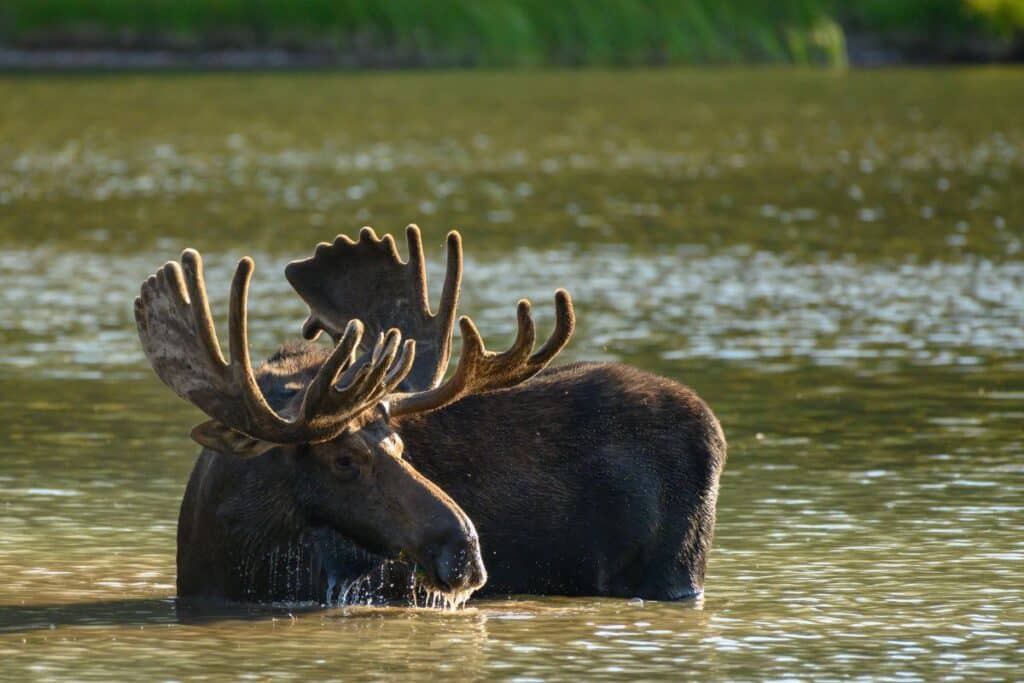Explore the best places in Montana to see wildlife, from Glacier Park to Yellowstone.
Get ready to fill your field glasses and flex your zoom lenses – we’re going on a wild ride through Montana’s top spots for wildlife watching!
We’ve tracked the trails and marked the maps to bring you the ultimate guide to catching a glimpse of Montana’s most iconic animals in their natural splendor.
Think of this as your treasure map to the animal kingdom’s hidden gems, from Glacier National Park’s agile mountain goats to the elusive wolves of Yellowstone. Each location offers a front-row seat to nature’s most unscripted moments.
So, gear up with your best outdoor ethics – think quiet footsteps and a leave-no-trace attitude – because we’re about to step into the lives of bison, bears, and bald eagles.
Ready for an adventure that’s as wild as the Montana skies? Let’s hit the road and spot some wildlife!
Glacier National Park – Mountain Goats
In the rugged wilderness of northwestern Montana, Glacier National Park stretches over a million acres, embracing a spectrum of ecosystems. Its glaciated landscapes, carved into serrated peaks and deep valleys, foster a diverse array of fauna.
Among them, the agile Mountain Goats have found a home on the precipitous cliffs, their iconic white silhouette standing stark against the alpine blue.
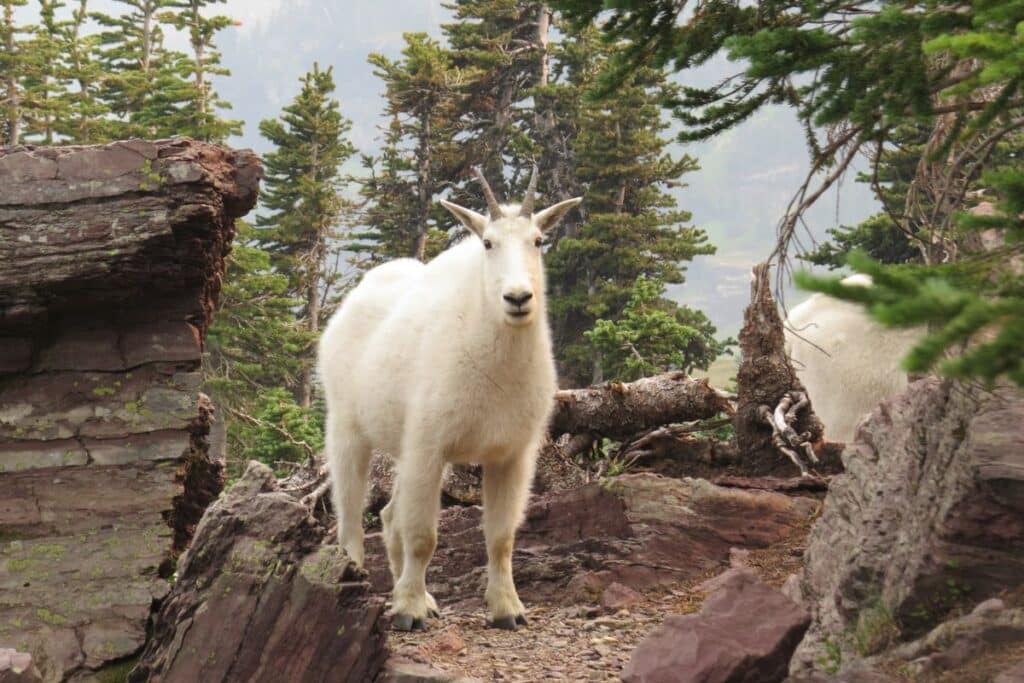
These fascinating creatures are nature’s skilled mountaineers, defying gravity with unique adaptations. Their split hooves have pliable pads for improved grip, and their muscular forequarters enable them to scale the steepest of rocks.
Their dense woolly coat provides essential insulation against the icy winds that sweep through the park.
For the most rewarding encounters, consider a trek along the Highline Trail, an 11.8-mile route that starts at Logan Pass. This trail, tracing the Garden Wall, offers stunning panoramas and frequent Mountain Goat sightings, especially during early mornings and late afternoons. Additionally, the Logan Pass Visitor Center and its surrounding meadows are popular hangouts for these goats in the summer.
For extended stays, camping at the Many Glacier Campground provides excellent opportunities for wildlife watching. But remember, while their calm demeanor can be deceiving, these are wild animals – maintain a respectful distance, ensuring their and our safety.
So, lace up your hiking boots, prepare your binoculars, and head into Glacier National Park for an unforgettable experience with the Mountain Goats, the true kings of these mountainous landscapes.
The National Bison Range – American Bison
Located in the heart of the beautiful Mission Valley, the National Bison Range is a historic sanctuary, covering over 18,500 acres of Montana’s spectacular landscape.
The rolling grasslands, riparian areas, and hilly forests here have been a refuge for the iconic American Bison since 1908, a testament to our commitment to preserving these magnificent beasts from the brink of extinction.
The American Bison, with their massive frames and shaggy coats, are symbols of strength and resilience. Once roaming the plains in colossal herds, their numbers dwindled drastically during the 19th century.
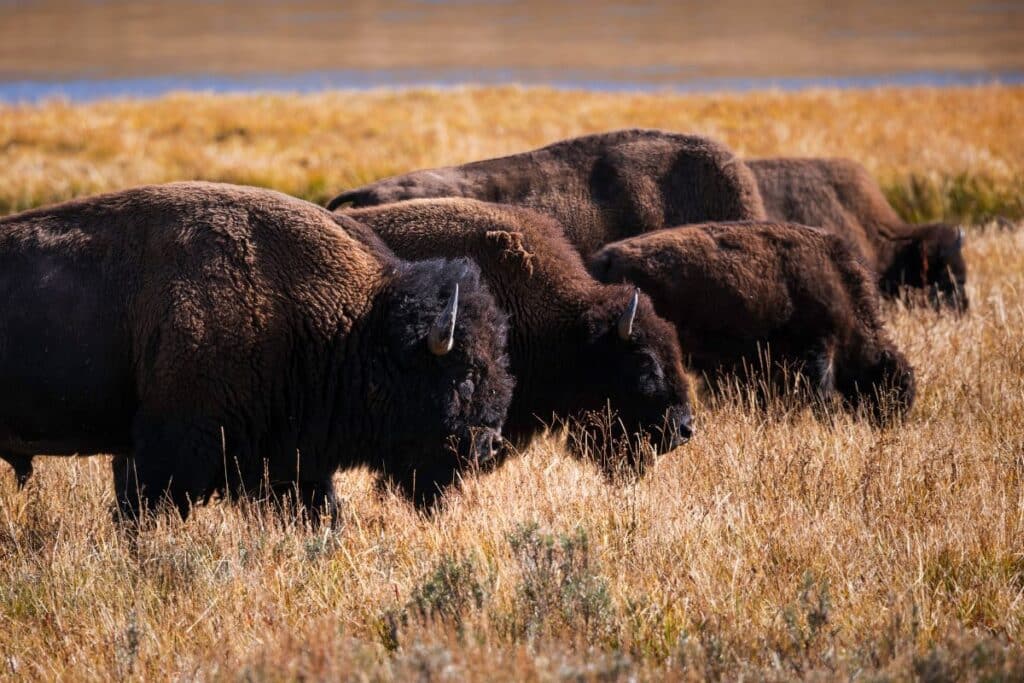
Yet, through dedicated conservation efforts, like those implemented at the National Bison Range, they have made a remarkable recovery. Today, these impressive animals, carrying both historical and ecological significance, are a sight that fills onlookers with awe.
To witness these herds, consider driving along the Red Sleep Mountain Drive. This 19-mile gravel road offers unparalleled views of bison grazing in their natural habitat, along with vistas of the valleys, rivers, and the distant Mission Mountains. Visit in the early mornings or late afternoons, when bison are typically more active.
Remember to respect these majestic creatures. Despite their lumbering gait, bison can reach speeds up to 35 mph and can be unpredictable. Always observe from a safe distance, using binoculars for a closer look.
Whether you’re an ardent wildlife enthusiast or a casual observer, a visit to the National Bison Range offers an unforgettable glimpse into the life and recovery of the American Bison, truly an emblem of the American West.
Yellowstone National Park – Wolves
Stretching across the volcanic highlands of Wyoming into Montana and Idaho, Yellowstone National Park is a geological marvel and a thriving hub of wildlife. Among its diverse inhabitants, the park is famed for one of nature’s most charismatic and contentious predators – the wolf.
Yellowstone’s wolves were eradicated by the 1920s due to predator control measures. However, in a historic effort to restore ecological balance, wolves were reintroduced from Canada in the mid-90s. Today, their haunting howls once again reverberate through Yellowstone’s valleys, a testament to one of the most successful wildlife conservation efforts.
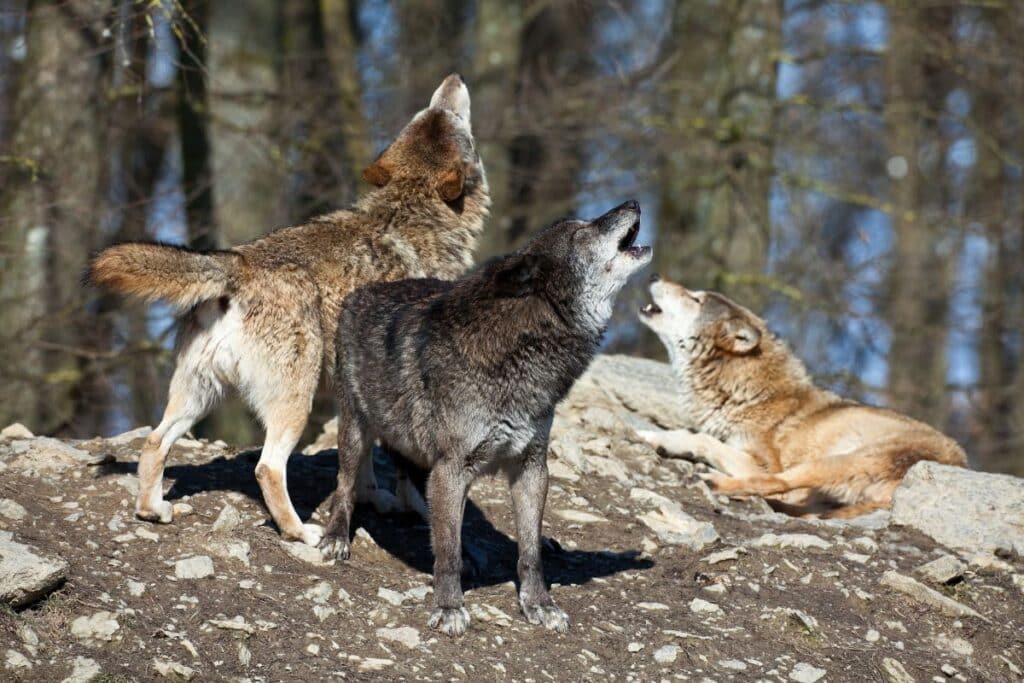
Wolves live in intricate social structures called packs, with a dominant alpha pair and their offspring. They are cooperative hunters, taking down large prey like elk and bison, and their presence influences the behavior of other animals, a phenomenon known as the ‘ecology of fear’.
To catch a glimpse of these elusive creatures, the Lamar Valley is your best bet. Known as ‘America’s Serengeti’, it is here that wolf packs are most frequently sighted, especially during dawn and dusk. Another promising locale is Hayden Valley, a lush expanse where wolves often roam.
When exploring, always maintain a safe distance, a minimum of 100 yards is recommended. Opt for guided tours or use spotting scopes for the best viewing experience.
A visit to Yellowstone, with its magnificent landscapes and the spectral presence of wolves, offers an unparalleled insight into the wild heart of America.
Bitterroot National Forest – Black Bears
Sprawled across the border between Montana and Idaho, the Bitterroot National Forest unfolds over 1.6 million acres of majestic peaks, lush valleys, and pristine waterways. Amidst the forest’s array of wildlife, the Black Bear stands out, an enduring symbol of North America’s wild places.
Black Bears are versatile omnivores with an impressive adaptation capacity. Their diet ranges from berries, insects, and fish, to mammals. The spectacle of a Black Bear foraging in a lush meadow or expertly climbing a tree with agility that belies their size is truly a sight to behold.
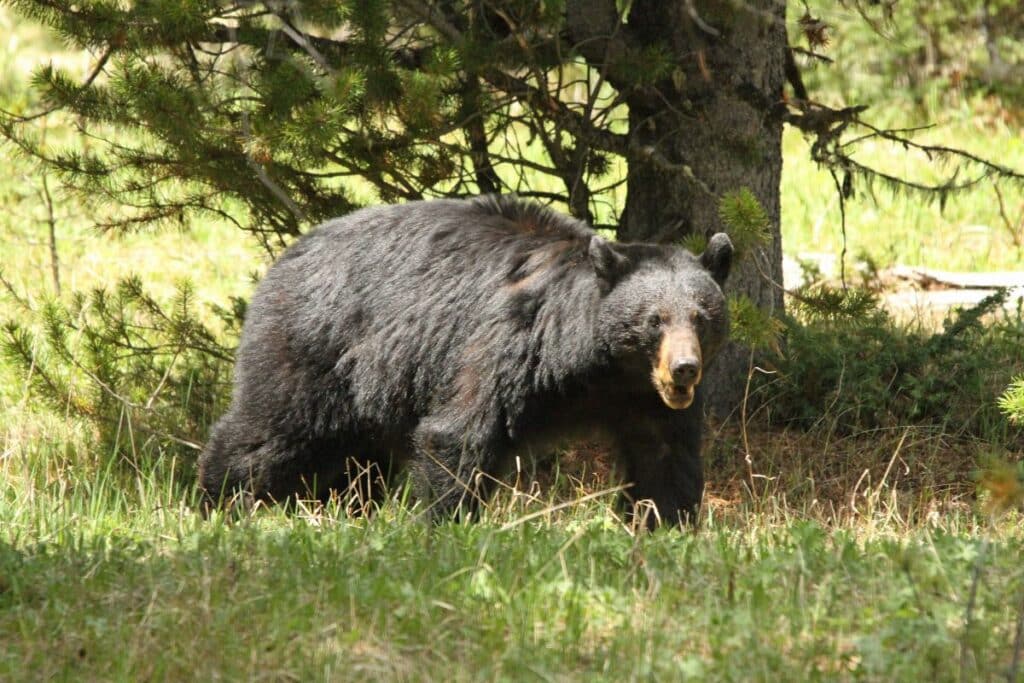
The Bitterroot National Forest offers several trails where Black Bear sightings are common. The Lake Como Loop, a popular 7-mile trail, often presents opportunities to observe these creatures, especially in the early morning or evening. Similarly, the Blodgett Canyon, with its stunning rock walls and vibrant ecosystem, is another frequented spot.
However, bear safety is crucial. Always maintain a safe distance – at least 100 yards. If camping, store food and other attractants properly to avoid unintentional bear encounters. Carry bear spray and know how to use it. Remember, we are visitors in their home.
Through its vibrant ecosystems and the quiet allure of the Black Bear, a visit to Bitterroot National Forest truly offers a fascinating encounter with nature’s untamed beauty.
Flathead Lake – Bald Eagles
Nested in the heart of Montana, Flathead Lake is a jewel of natural splendor. Covering nearly 200 square miles, it’s the largest natural freshwater lake west of the Mississippi. The lake’s shimmering sapphire waters, fringed by rolling hills and evergreen forests, host a rich tapestry of life, including the resplendent Bald Eagles.
Bald Eagles, America’s national bird, symbolize freedom and strength. Known for their striking white heads and tails contrasted against dark bodies, they showcase an exceptional hunting prowess. With keen eyesight and deadly precision, they swoop down to seize fish from the lake’s surface, a sight that is nothing short of spectacular.
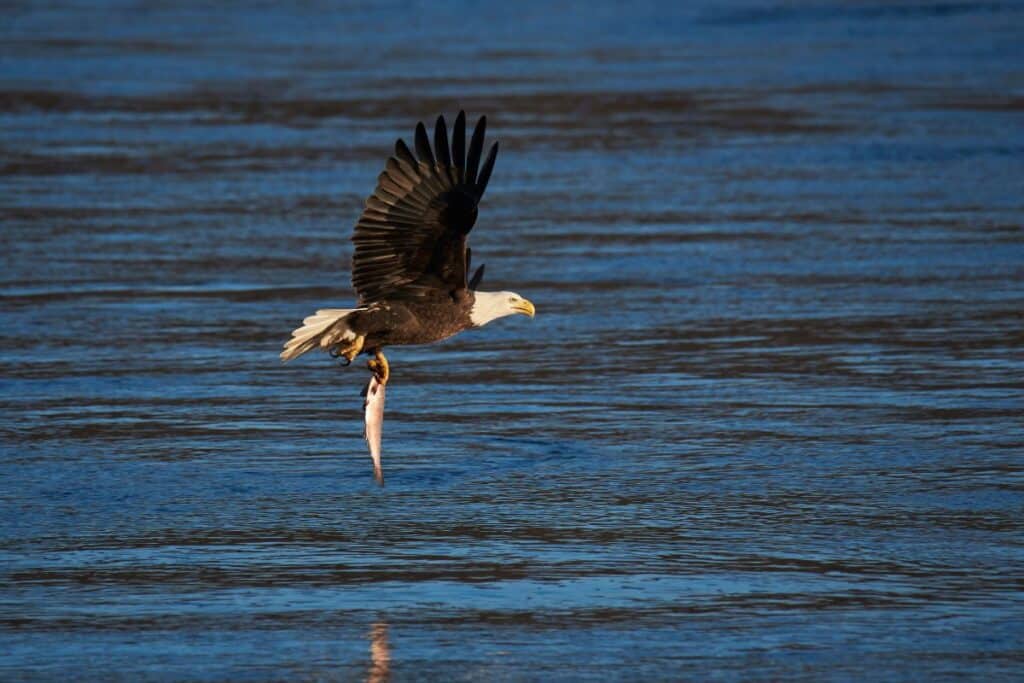
Owing to tireless conservation efforts, Bald Eagles have made a remarkable comeback from the brink of extinction. Today, Flathead Lake offers some of the best opportunities to observe these magnificent birds in action. The lake’s numerous islands, especially Wild Horse Island, provide ideal nesting habitats for eagles and are perfect for bird watching.
Early mornings and late afternoons, when eagles are most active, are the best times for observation. And winter, when the lake’s fish are more visible, offers particularly rewarding eagle-watching experiences. Remember, respect these magnificent birds by observing from a distance and avoid disturbing their nesting areas.
A visit to Flathead Lake presents not only a tranquil retreat but a chance to witness the soaring majesty of the Bald Eagles in their natural habitat – a testament to the triumph of conservation and the enduring grandeur of nature.
Custer Gallatin National Forest – Moose
Spanning over three million acres from the heights of the Rocky Mountains to the vast plains of South Dakota, the Custer Gallatin National Forest is a place of profound natural beauty. Within its diverse ecosystems, one creature stands head and shoulders above the rest – the impressive Moose.
Moose, the largest member of the deer family, are easily identifiable by their towering stature, long snout, and the males’ distinctive fan-shaped antlers. These majestic herbivores have adapted to life in the forest’s wet areas, where they feed on aquatic vegetation during summer and switch to twigs and bark in winter.
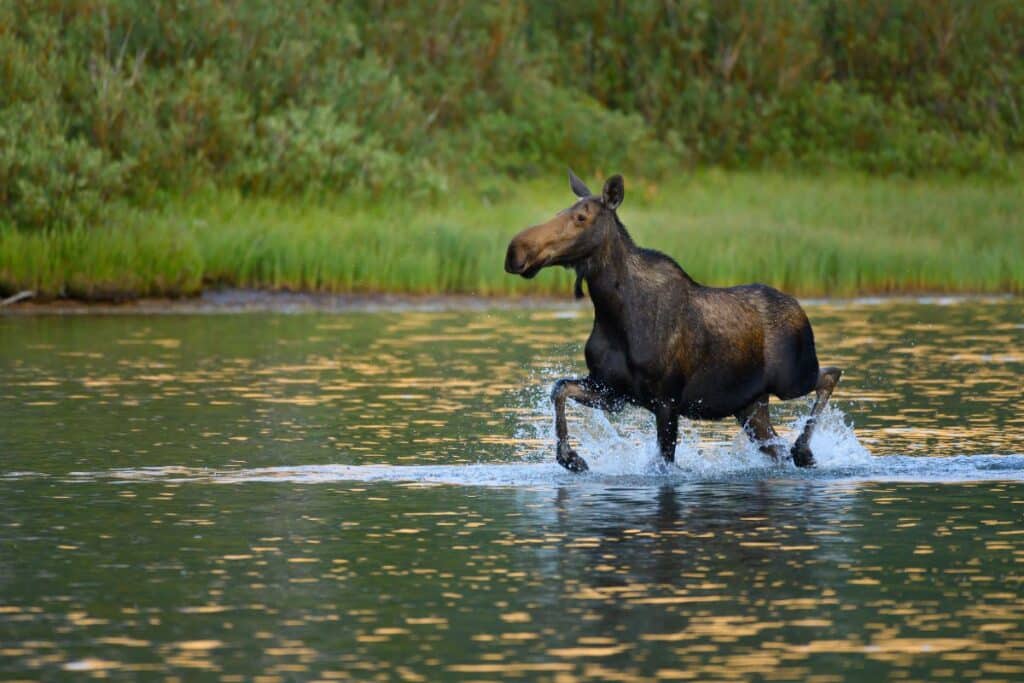
The forest’s countless rivers, ponds, and marshy meadows provide perfect habitats for moose. Trails such as the Hyalite Creek Trail or the Lava Lake Trail in the Gallatin Range present excellent opportunities for encounters. Early mornings or late afternoons, when moose are most active, are the best times to spot them.
While these gentle giants may appear docile, they can be unpredictable and will defend themselves if they feel threatened. Maintain a safe distance of at least 50 yards, and use binoculars or a camera with a zoom lens for a closer look.
A visit to the Custer Gallatin National Forest offers not only a retreat into an immense wilderness but also the possibility to observe the majestic Moose in its natural habitat, a truly awe-inspiring sight.
Beartooth Wildlife Management Area – Bighorn Sheep
Tucked away in the rugged landscapes of Montana, the Beartooth Wildlife Management Area is a tranquil sanctuary spanning nearly 30,000 acres. This untamed wilderness is home to a myriad of species, but the true stalwarts of these rocky terrains are the Bighorn Sheep.
Bighorn Sheep, with their impressive spiraled horns and sturdy build, are a sight that commands admiration. Perfectly adapted to life on precipitous slopes, these creatures demonstrate extraordinary climbing skills, often navigating nearly vertical cliffs with grace and agility.
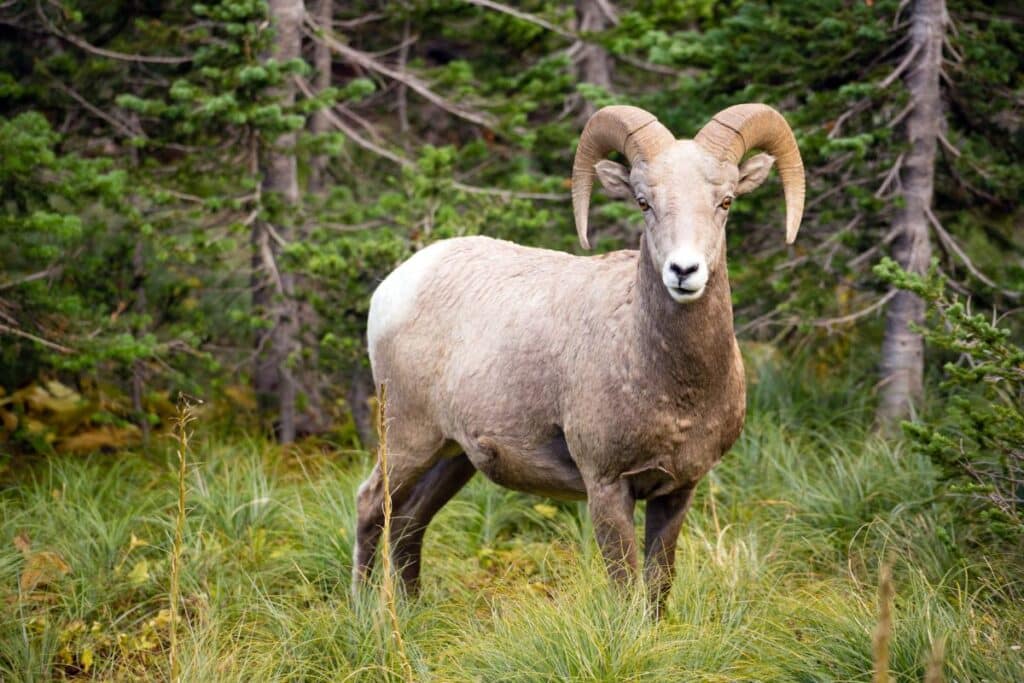
In the Beartooth Wildlife Management Area, the alpine meadows and rocky outcrops provide excellent habitat for these sheep. The Beartooth Highway, with its stunning panoramas, offers ample opportunities for sightings, especially during the early morning and late afternoon when these animals are most active.
Bear in mind that Bighorn Sheep are shy creatures. To ensure a successful viewing, keep your distance, remain quiet, and avoid sudden movements. Binoculars or a telephoto lens can enhance your viewing experience without causing any disturbance.
The secluded wilderness of Beartooth, accompanied by a chance to observe the majestic Bighorn Sheep in their natural habitat, offers an unforgettable communion with nature’s sublime grandeur.
Bob Marshall Wilderness – Elk
Covering over a million acres of untouched wilderness in Montana, the ‘Bob’, as the Bob Marshall Wilderness is affectionately known, is a place of sublime solitude and raw natural beauty. Amidst its extensive landscapes, from lowland forests to alpine meadows, thrives the majestic Elk.
Elk, or wapiti, are one of the largest species within the deer family, known for their impressive antlers and regal bearing. They play a vital role in the ecosystem of the ‘Bob’, influencing vegetation patterns with their feeding habits and providing sustenance for predators like wolves and bears.
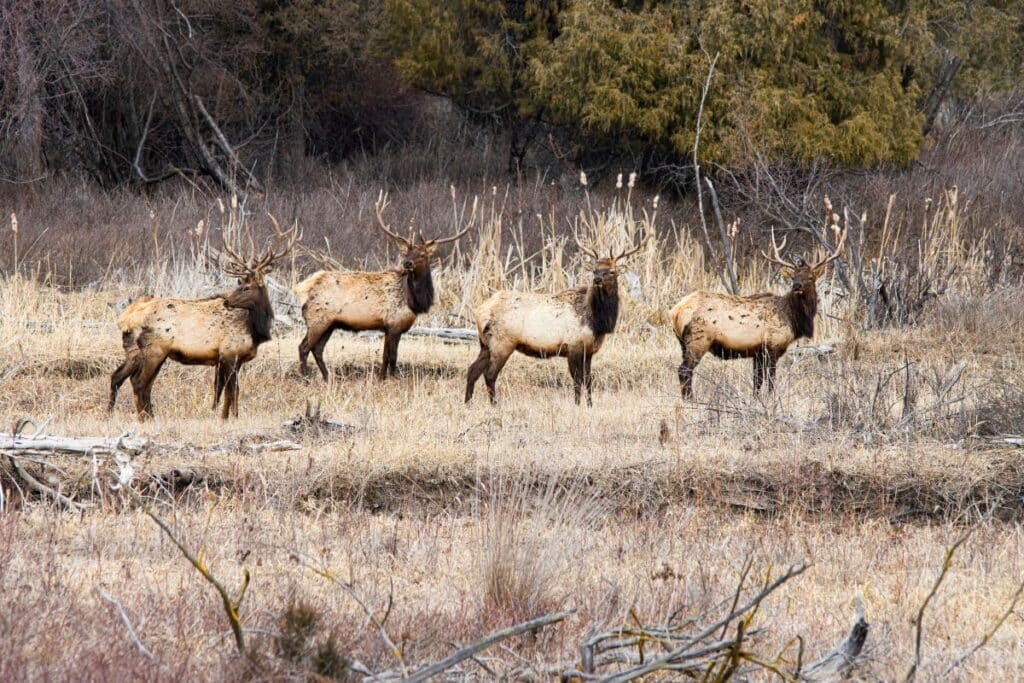
In the fall, during the rutting season, bull elk engage in a dramatic display of bugling and sparring to establish dominance and win over the females. These powerful contests are a spectacle that echoes through the wilderness, captivating all who are fortunate enough to witness them.
The South Fork of the Flathead River and the trails around it, such as the Meadow Creek Trail, offer promising elk spotting opportunities, especially in the early morning and late evening hours when they are most active.
However, be mindful to observe from a distance and use binoculars or a telephoto lens for a closer look. Always respect the elk’s space, especially during the rut when bulls can be particularly aggressive.
Immersing yourself in the Bob Marshall Wilderness and witnessing the majestic elk in its natural habitat offers a profound connection with the untamed spirit of nature.
Bighorn Canyon National Recreation Area – Wild Horses
Nestled within the rugged landscapes of Montana and Wyoming, the Bighorn Canyon National Recreation Area boasts a rich diversity of ecosystems. Stretching over 120,000 acres, the area’s wild, untamed beauty is accentuated by the presence of a truly iconic symbol of the American West – the Wild Horses.
Descendants of horses brought to North America by Spanish explorers, these animals have roamed freely for centuries. Their resilience and ability to thrive in harsh conditions speak to the enduring spirit of the wilderness. Watching a band of these wild horses galloping across the sagebrush prairies is a spectacle that captures the essence of the American frontier.
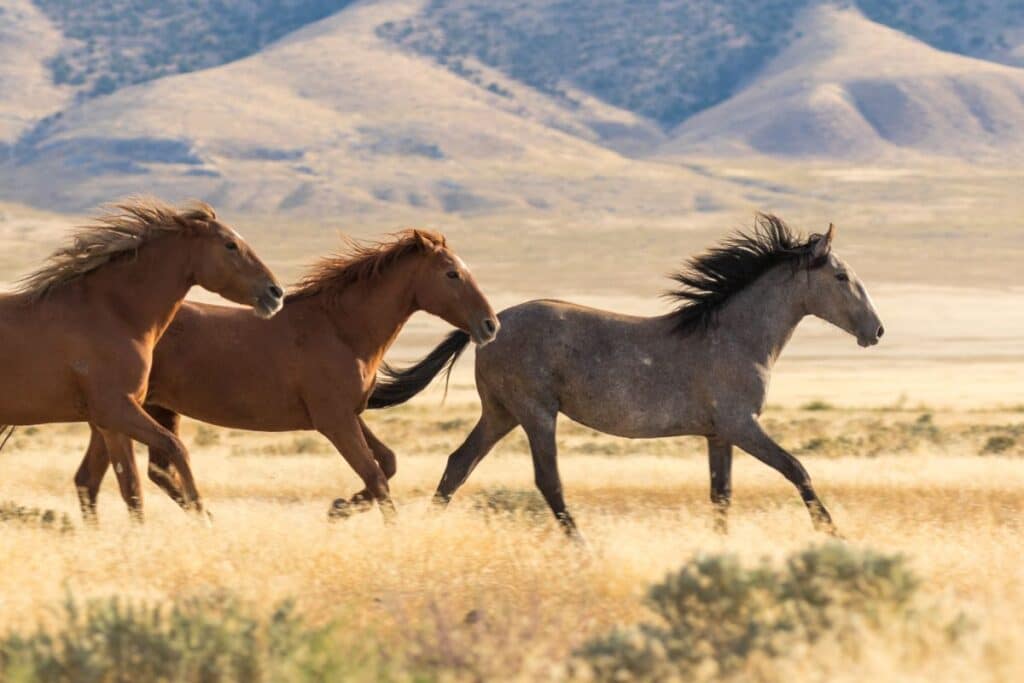
The Pryor Mountain Wild Horse Range, located within the recreation area, is one of the best places to view these magnificent creatures. The Dryhead Overlook and the Mustang Flats, accessible via the main park road, offer sweeping vistas where the horses are often spotted, especially during the early morning or late evening.
When viewing these majestic creatures, it’s important to remember they are wild. Maintain a safe distance of at least 50 feet, and do not attempt to feed or touch them. Use binoculars or a telephoto lens for a closer look.
A visit to the Bighorn Canyon National Recreation Area, with its dramatic landscapes and roaming wild horses, offers a captivating glimpse into the untamed heart of the American West.
Charles M. Russell National Wildlife Refuge – Pronghorns
Stretching over a million acres along the Missouri River, the Charles M. Russell National Wildlife Refuge is a testament to the untouched beauty of Montana’s prairie land. Within its sprawling landscapes, one creature epitomizes the spirit of the American grasslands – the remarkable Pronghorn.
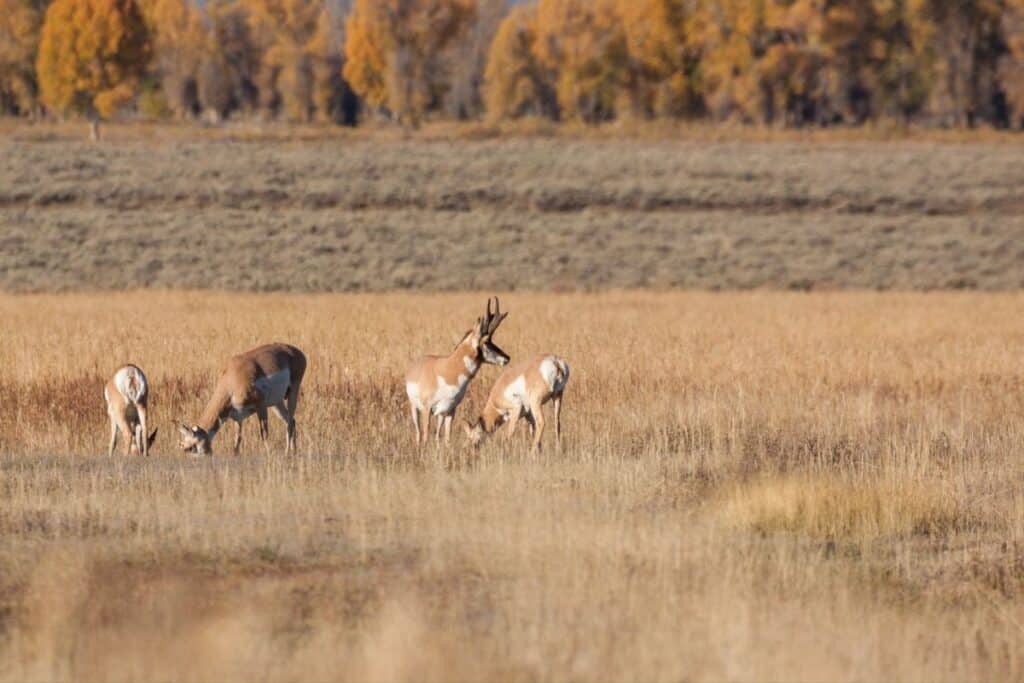
Known for their distinctive horns and white markings, Pronghorns are a marvel of evolutionary adaptation. They are North America’s fastest land animals, capable of reaching speeds up to 60 mph, a trait developed to evade extinct predators. Unlike other antelope, Pronghorns are not jumpers but prefer to crawl under or through barriers, an intriguing behavior that speaks to their unique lineage.
The refuge’s mixed-grass prairie offers an excellent habitat for Pronghorns. The Wildlife Drive, a 19-mile self-guided auto tour, provides ample viewing opportunities, particularly in the early mornings and late afternoons when Pronghorns are most active.
When observing these remarkable animals, it’s vital to maintain a safe distance and avoid any actions that might cause them to flee. Remember, these creatures’ survival depends on their energy reserves, and unnecessary running depletes these reserves.
A journey through the Charles M. Russell National Wildlife Refuge, with its vast landscapes and fleet-footed Pronghorns, is a journey into the heart of America’s wild frontier
Final Thoughts
As we bring our journey to a close, we reflect on the staggering diversity of Montana’s wildlife. From the Mountain Goats of Glacier National Park to the Bighorn Sheep in the Beartooth Wildlife Management Area, each creature plays a significant role in the intricate tapestry of life that spans the state’s varied landscapes. But remember, when we venture into these wild spaces, we are guests in their home.
Each of us has a responsibility to practice respectful wildlife viewing – keep a safe distance, do not disturb or feed the animals, and leave no trace of our visit. In doing so, we ensure the preservation of these magnificent creatures and their habitats for generations to come.
As we venture forth from the wilds of Montana, may we carry with us not only vivid memories but also a renewed commitment to safeguarding the vibrant life that thrives within them.

